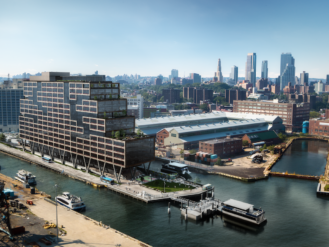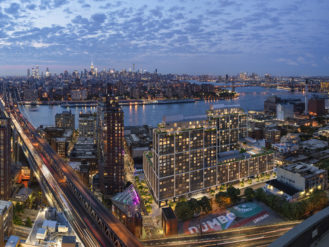Down to the Wire: What’s the Compromise on 80 Flatbush?
Council Member Levin calls for a cut in the project's bulk—and presses for more transparency about its opaque financial terms
The 80 Flatbush project would join a growing cluster of downtown skyscrapers, including the supertall 9 Dekalb, to the right of 80 Flatbush in this rendering. The historic Williamsburgh Savings Bank building is in the foreground (Courtesy of Alloy Development)
As the 80 Flatbush project approaches a vote in the New York City Council, District 33 Council Member Stephen Levin, who represents the site, has made a counter-proposal: The developers should cut the controversial, two-tower development’s bulk by one third. While that sounds like a dramatic downscaling of the project’s ambition, it’s a compromise. The size would still be nearly double what’s allowed under current zoning law.
It’s not uncommon for developers pursuing a rezoning to request more than they need, with a scaleback in mind that would allow most parties to claim a win. But 80 Flatbush has been especially contentious, with executives at Alloy Development, backed by many city and business officials, insisting that towers rising 986 feet and 561 feet, accommodating 900 apartments and 200,000 sq. ft. of office space, plus two schools, are appropriate for the site.
Since the judgment of the council member representing the neighborhood tends to carry the day with colleagues, all eyes have been on Levin to see where a compromise might be reached. His request to the developer, first reported by the Brooklyn Paper, would axe the proposed office space, but aims to keep the planned new elementary school and a replacement for a high school, the Khalil Gibran International Academy (KGIA), which currently occupies outdated structures at the site.

The development would take place on a trapezoidal block near the Hub tower (left), 300 Ashland (center-right) and the former Williamsburgh Savings Bank building (Photo-illustration by Alloy Development)
It echoed a proposal from the Boerum Hill Association, which represents neighbors of the site and has softened its resistance somewhat. (Earlier, Community Board 2, agreeing with the BHA, nearly unanimously opposed the proposal.) The BHA, Levin said, had suggested decreasing the project’s proposed Floor Area Ratio (FAR), a measure of bulk as a multiple of each full lot, to 12, down from the developer’s requested 18.
A FAR of 12 happens to be the maximum in Brooklyn’s Central Business District, well above the 6.5 FAR currently allowed at the 80 Flatbush site, which bridges major development and row houses. With a bonus for school space, Levin told The Bridge, the FAR could go to 13.87.
Opponents have argued that the two-tower project would overwhelm the block, while supporters say the location, near the Atlantic Terminal transit hub, is a good place to grow housing and schools. Previously the BHA had called an upzoning to an FAR of 12 “aggressive” and the requested tripling to 18 “absurd.”
“For 16 months we’ve pushed for one tower, one school,” as well as building setbacks for transition and townhouses on part of the site, BHA President Howard Kolins told The Bridge. “After much discussion, we thought FAR 12 might result in a reasonable compromise.” It also seems to accommodate two towers, though reconceived.
It’s unclear whether the compromise would be enough to provide all of the proposed affordable housing—200 units are in Alloy’s plan. But Levin seems to be acknowledging that the Special Downtown Brooklyn District, identified in 2004 by the City Planning Commission as a transition zone, could stretch at the seams.
Alloy’s request of a FAR of 18 is unprecedented in Downtown Brooklyn. Borough President Eric Adams, who recommended cutting the height of the taller tower to 600 feet, to conform to the tallest building nearby, 333 Schermerhorn St. (known as the Hub), essentially endorsed an FAR of 15.8 for 80 Flatbush.
Would either of these proposed compromises by elected officials be financially feasible? The question lingers because—as elicited at a City Council subcommittee hearing last month—the financial deal behind the project is opaque. The only players who know the full details of the deal are the developers, Alloy, and the Educational Construction Fund (ECF), an adjunct of the New York City Department of Education, which partners with developers to construct schools with no direct capital outlay.
After meeting last week, Levin and the project sponsors plan to meet again late this week. If the plan is not modified, the City Council would vote at its Sept. 12 meeting, but a modification would push back the vote until Sept. 26.
The Back and Forth
At a hearing Aug. 14, held by the council’s Subcommittee on Zoning and Franchises and lasting nearly five hours, Levin said project opponents had “by and large” come in good faith, and that Alloy had “put forward a good faith effort … to incorporate good design elements and work with the community.” But, he said, the proposal far exceeded Boerum Hill’s scale or that of the special district.
Carol Rosenthal, Alloy’s land-use counsel, pointed out that some older buildings in Downtown Brooklyn have a FAR of 21 or 23, and that other business districts in the city have larger towers. But when Levin invoked more recent zoning, Alloy CEO Jared Della Valle said, “It’s important to be thinking forward, not just reflecting on the past.”
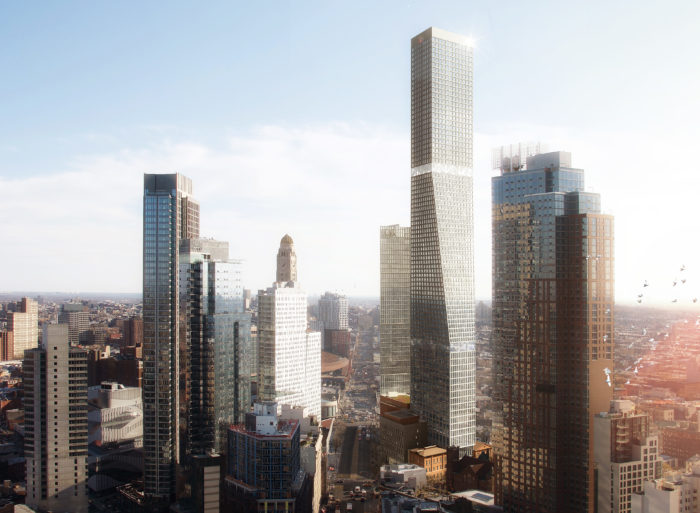
The taller of 80 Flatbush’s two towers would be cut to the height of the Hub, at right, according to Borough President Adams’s recommendation
Levin, who said no one denied that Flatbush Avenue merited higher density, again cited the 2004 zoning decision, asking semi-rhetorically: “Is it still the policy of the city that there ought to be transitional zoning blocks?”
“What’s changed between 2004 and now is incredible,” said Rosenthal. “Zoning, we don’t think of as static, because the city is always growing and changing.” She said the 80 Flatbush design is sensitive to the brownstone block of State Street, given tower setbacks and the elimination of auto parking within the project, which would tend to lessen the project’s impact on traffic congestion.
“Design is important,” Levin said, but “there’s only so much that that you can do” when exceeding the zoning framework. “It’s been frankly frustrating,” he said, that the development team and administration show “a real reluctance to use the world ‘transitional.’”
Subcommittee Chair Francisco Moya, who represents the 21st Council District in Queens, pressed Della Valle: “Do you have plans to respond to the community and borough president on height and scale?”
“We’ve very much enjoyed our dialogue with the community, with the borough president, with the council member,” Della Valle replied. “We think design, being that we’re an architecture company at heart, is an opportunity to solve a lot of problems. We look forward to working with the council member. We believe height is appropriate here; that said, we’re listening carefully.”
Moya also queried Jennifer Maldonado, executive director of the fund: “Has ECF ever undertaken a similar project when the majority of the site is on private land?”
The answer was no.
“Has ECF ever used an 18 FAR district in prior projects?” Moya asked.
Maldonado said she wasn’t sure, and would have to check on whether the Murry Bergtraum High School, which is connected to the Verizon Building in Lower Manhattan, qualified.
Levin said Friday that he was wary of 18 FAR as a precedent in the Downtown Brooklyn area, but that, at the recent meeting, 80 Flatbush sponsors “did not think that [FAR of 12] was viable. But we have to get closer into what is viable… I’m not saying I’m going to turn down the project no matter what. I want to give the process the time to see if a solution can be arrived at.”
Drilling Down on the Transaction
At the hearing, Levin also questioned the Alloy-ECF transaction. The lack of transparency means that citizens and elected officials don’t know the calculations behind the upzoning, which enables additional bulk, allowing new market-rate residential aparatments to cross-subsidize the affordable units and schools.
The deal has been framed as a rewarding one for the community. Citing the new schools and affordable housing, Della Valle declared, “All told, 80 Flatbush affords over $230 million in public benefit at zero cost to the city.”
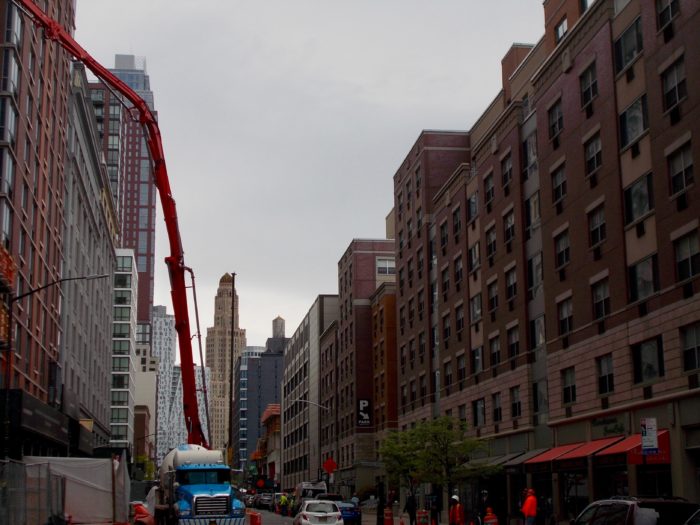
Looking east along Schermerhorn Street, where the taller 80 Flatbush tower would be situated down the block on the right side of the street. The Hub is the tallest building at left (Photo by Norman Oder)
Or, more precisely, zero cash. As the testimony elicited, it’s complicated. The Dumbo-based real estate company controls most of the site bounded by Flatbush and Third avenues and State and Schermerhorn streets; the ECF will control the city’s portion of the site, which is 23%.
Levin pressed the EFC’s Maldonado to explain the transaction. The city, she said, would convey its property to ECF for a mixed-use development structure, including schools. ECF would own the land and lease the site to Alloy. The developer would pay both rent and the equivalent of taxes (since city property is tax-exempt) to pay off tax-exempt bonds, to which it gains access via that partnership.
Have ECF and Alloy, asked the council member, agreed on rent?
“We have a term-sheet agreement,” which has the rental terms, Maldonado responded. “We still have our lease and development agreement that’s still being worked out.”
“Can you share the rental terms?” he asked.
No, said Maldonado, since some elements remain under negotiation, “but once we sign everything.”
“That will be before or after [the] council votes? Levin asked.
“That will be after,” Maldonado replied, prompting scornful laughter from some audience members. “It’s contingent on the approval process.”
Levin didn’t buy it. When the council in 2015 reached a development deal regarding the Brooklyn Heights library site, “the price of the sale was set prior to the council taking action,” he said. “The city financial agreement with the developer is integral to driving the scale of the project, or what the project entails… It seems to me that the scale of the project is driven by the cost associated with the benefits.”
“Correct,” Maldonado said. She pledged to check that day regarding “what my legal structure allows for” regarding deal transparency.
“It’s a public project with public land, so it needs to be public,” Levin told The Bridge shortly after the hearing. He has since been provided with some documents, he said on Friday, but was told he can’t make them public. This journalist’s query to the ECF is pending.
What Exactly Is the City Giving Away?
The apartments owned by the ECF—225 market-rate units in the first, shorter tower—wouldn’t pay taxes. Asked Levin, “Do we know what that tax equivalency would be?,” meaning what the city might collect from a similar project, structured without the tax break?
Maldonado said no. Della Valle noted it was based on an assessment.
“In other words, the city is foregoing tax revenue,” Levin noted.
“There’s no revenue currently on the site,” Maldonado responded.
Levin suggested doing the math: “It’s not as if it’s totally free, that these schools are being created entirely for free, because we are foregoing tax revenue.”
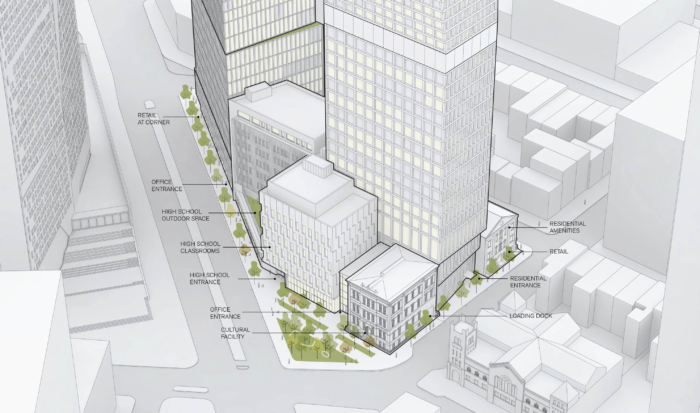
Historic buildings would be retained alongside the new towers (Rendering courtesy of Alloy Development)
“Nothing is free in this world,” countered lawyer Rosenthal. “You’re taking the 23%, which doesn’t pay taxes, and trading them for the ECF units and schools.” (The outdated Khalil Gibran school would be replaced and expanded, to 350 seats, and a new 350-seat elementary school would be built. However, given projected demand from 80 Flatbush residents for school spaces, there would be only 168 net new seats.)
“And a 900-foot building,” said Levin. In other words, the rezoning creates hundreds of thousands of new buildable square feet.
“Yes,” said Rosenthal, “and you get the rest of the development too.” (The second, larger building, also will contain the affordable units, subsidized by the market-rate units.)
Later, Ben Richardson, treasurer of the Fort Greene Association, contended that the city was giving Alloy and ECF $300 million worth of land and air rights. That hasn’t been confirmed by an independent entity; calculations can get complicated.
Jay Marcus of the Fifth Avenue Committee, Alloy’s affordable-housing partner, noted that most of the city’s rezonings have been in lower-income communities, where land costs less. “This is a higher-income community,” he said. For the city’s Mandatory Inclusionary Housing (MIH) policy to work, when only part of the land is city-owned, “you do need to have higher density.”
If the density is at least partly driven by the cost of land—Alloy spent about $80 million—the need for the project’s benefits stems partly from failures in the 2004 rezoning of Downtown Brooklyn, which allowed larger buildings to foster office space but instead ushered in a flood of market-rate apartments, with no requirement for affordability, nor any planning for schools. Thus the resolution for 80 Flatbush might send signals well beyond the immediate stakeholders.






